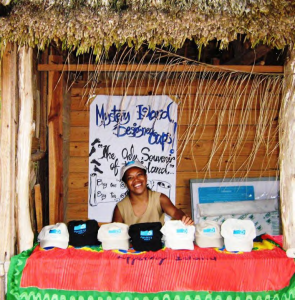
The private sector: the new black in women’s economic empowerment
By Kate Nethercott and Marianne Jago-Bassingthwaighte
8 March 2013
To celebrate International Women’s Day this year we’d like to highlight some exciting and worthy achievements in international development for women. We’ve just completed some research for AusAID’s Enterprise Challenge Fund (ECF) (ECF Women’s Economic Empowerment) showing impressive results from the private sector’s work with women: investing in them as small business owners, employees and suppliers and targeting them as clients. As you’ll see from our report, the flourishing of this public-private partnership (MDG8) has meant that Lili Watts, a vegetable gardener in Solomon Islands, can feed her family (MDG1), has been able to send two children to school (MDG2), and birth her fifth in a health centre (MDGs 4 and 5). Show us women’s economic empowerment and we’ll show you the fastest, most sustainable route to development on earth.
But before we delve further into the research we’d like to discuss the sorry state of donor budgeting for women’s economic empowerment. As we note in our report, the links between improving women’s economic empowerment and overall economic growth are well recognised in international development practice, research and policy communities. For example, AusAID’s 2011 Gender Equality Strategy and AusAID’s 2012 Sustainable Economic Development: Private Sector Development Strategy make a big deal of the importance of improving women’s economic empowerment. And yet it is not identified as an objective in current development initiatives focused on economic growth, the ECF among them. This is more than a little perplexing given the existing policy framework.
Now back to the good news. Our research found that across a number of ECF case studies, even though women’s economic empowerment was not a specific program objective, there were encouraging gains in women’s economic empowerment. In short: women’s earnings increased; they had better access to employment, education and services; and they became more influential in their communities. Just imagine the outcomes if women’s economic empowerment had been an explicit objective of the program!
Here are some of the key research findings from the case studies we examined, which also give some clues into how these gains for women’s economic empowerment were won:
- The private sector welcomes this research – it is convincing and highlights the business case for focusing on women;
- The private sector has a niche role in increasing access to technology (e.g. mobile banking) that empowers women;
- The best results come through private sector partners who are already interested in social development and women’s inclusion as they are willing to innovate and provide flexible work arrangements for women;
- Good results also come from targeting economic sectors where women already participate;
- Donor funded programs can be influential with the private sector by building awareness of gender equality and women’s economic empowerment, and including explicit objectives and indicators in design, funding and monitoring processes;
- Motivated staff within donor and partner organisations can make a big difference, even in the absence of explicit objectives for women’s economic empowerment;
- More research is needed to increase understanding of what works and what doesn’t, and to explore women’s economic empowerment in differing national, regional and cultural contexts.
 As we noted earlier, even in the absence of an ECF objective around women’s economic empowerment, the project has achieved some impressive results. Imagine what the public and private sectors could do if they put a big effort into women’s economic empowerment, and designed and funded programs that chased this important objective as though it were a seat on the UN Security Council? We won’t really know until it happens, but the pace to date has been, well, glacial.
As we noted earlier, even in the absence of an ECF objective around women’s economic empowerment, the project has achieved some impressive results. Imagine what the public and private sectors could do if they put a big effort into women’s economic empowerment, and designed and funded programs that chased this important objective as though it were a seat on the UN Security Council? We won’t really know until it happens, but the pace to date has been, well, glacial.
There is a bigger question: what happens in the political and bureaucratic process that sees courageous and important policy being lost in its translation into programs and funding?
Clearly, this question is not limited to gender equality (ask anybody who works in disaster prevention). Is it really the case that there is not enough political will to get behind a push to make sure the economic empowerment of women is the high priority development objective it deserves to be? Are not the exponential savings in development dollars down the track, quite apart from the human rights imperative (OECD DAC 2012 Paper Women’s Economic Empowerment), sufficiently compelling?
The lessons from our research into women’s economic empowerment through the ECF are already proving to be of significant interest to the international development community and AusAID. Leading edge policy is a good start for Australia’s aid program. Good practice that is resourced well must follow, if we are to see the improvements in gender equality and women’s economic empowerment that we know are among the shortest routes to sustainable development.
Kate Nethercott is an Independent Consultant specialising in Gender Equality and Social Inclusion. Marianne Jago-Bassingthwaighte is Principal at Kencho Development Consulting and a Research Fellow at the Centre for Disaster Studies, James Cook University.
About the author/s
Kate Nethercott
Marianne Jago-Bassingthwaighte
Marianne Jago-Bassingthwaighte is Principal at Kencho Development Consulting and an Adjunct Lecturer and Research Fellow at James Cook University. She is a former AusAID employee.
